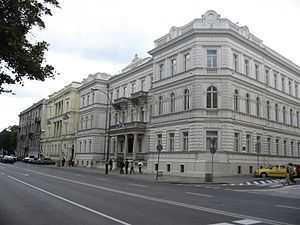Ujazdów Avenue

Ujazdów Avenue (Polish: Aleje Ujazdowskie) is a major thoroughfare parallel to the Vistula River in the Śródmieście district of Warsaw, Poland.
History
The origins of the avenue date to 1724-1731, when King August II ordered the construction of the Calvary Road (Droga Kalwaryjska). By 1766, the route was already a part of the Royal Route as Belweder Avenue, leading to Belweder Palace. In the second half of the 19th century, a number of villas and palaces owned by Polish aristocrats and industrialists were built along the route. Following the restoration of Polish independence in 1918, a number of these houses were transformed into foreign embassies. During World War II under the Nazi occupation, it was planned to be transformed into a German district, according to the Pabst Plan.[1] Nazi authorities renamed the avenue to Lindenallee and later to Siegenallee.[1] During the Warsaw Uprising in 1944, the street and the surrounding buildings were mostly destroyed.[2] In the war's aftermath, the avenue experienced massive reconstruction, with works lasting until 1955.[2] In 1953, following the death of Joseph Stalin, authorities renamed the thoroughfare as Stalin Avenue (Aleja Stalina). Three years later during the Polish October, a period of de-Stalinization, the avenue's traditional name was restored.[2]
In 1994, as part of the Royal Route, Ujazdów Avenue was named as a national historical monument by President Lech Wałęsa.[3] In 2009, Ujazdów Avenue underwent a complete renovation, with the planting of new trees, the complete reconstruction of sidewalks, bus turnouts, and creating bike paths for the route.[4]

Location
Located in the Śródmieście district, Ujazdów Avenue begins at Belweder Street and runs for 1.6 km to Three Crosses Square. The contemporary avenue is surrounded by many notable historical villas, parks and palaces, as well as politically important buildings. Notable landmarks along Ujazdów include the Chancellery of the Prime Minister, Ujazdów Castle, Ujazdów Park, Łazienki Park, the Botanical Gardens, the Ministry of Justice, St. Alexander's Church and several embassies, including those of Switzerland, the United States, the United Kingdom, New Zealand, Bulgaria and Lithuania.
In addition to street traffic, Ujazdów is also used for ceremonial purposes as a military parade route during Armed Forces Day, held annually on 15 August.
Image gallery
-
Sobański Palace
-

The Chancellery
-

Leszczynski Palace
-
President Lech Kaczyński reviewing troops on Ujazdów Avenue during Armed Forces Day in 2007
-
The embassy of New Zealand
-
The embassy of Montenegro
-
The German Historical Institute of Warsaw
References
- ↑ 1.0 1.1 Aleje Ujazdowskie at the official website of the Capital City of Warsaw
- ↑ 2.0 2.1 2.2 Aleje Ujazdowskie at the official website of Śródmieście district
- ↑ "Zarządzenie Prezydenta Rzeczypospolitej Polskiej z dnia 8 września 1994 r. w sprawie uznania za pomnik historii.(M.P. 1994 nr 50 poz. 423)". Sejm. Retrieved 22 November 2013.
- ↑ Lorenc, Sławomir. "Historia Alej Ujazdowskich". Aleje Ujazdowskie. Retrieved 22 November 2013.
| Wikimedia Commons has media related to Aleje Ujazdowskie. |
Coordinates: 52°13′17″N 21°01′29″E / 52.22131°N 21.02477°E







